- Home
- Encyclopedia
- Converse County, Wyoming
Converse County, Wyoming
The Early Years
Lt. Col. William J. Fetterman, like George Armstrong Custer, foolishly led his troops into an ambush. Fetterman and his entire command were wiped out by Cheyenne and Sioux warriors in 1866 on the east flank of the Bighorn Mountains. While Custer, whose famous defeat came a decade later, lives on in film and legend, Fetterman has largely been forgotten--save for the remains of the fort named for him.
Fort Fetterman, on the North Platte River 175 miles south of where Fetterman was killed, was built in 1867 in what would eventually become Converse County.
But already by then, the North Platte had offered one of the main routes west for white people. Trappers beginning in the 1820s, emigrants bound for Oregon, California and Utah in the 1840s, and stagecoaches and the Pony Express in the 1850s and 1860s all used the route heavily. It’s generally known as the Oregon Trail.
An early trading post about where Deer Creek flowed into the North Platte, near the present western boundary of Converse County, developed into a stage stop, Pony Express and telegraph station by the 1860s.
Fort Fetterman was built about 20 miles east of Deer Creek, on a high bluff above the south bank of the river, and became an important staging point for the army in the Indian Wars of the 1860s and 1870s.
Fifteen years later, after the government decommissioned the fort, the site continued life as a rowdy civilian frontier outpost where cowboys, trail hands and former soldiers could blow their money.
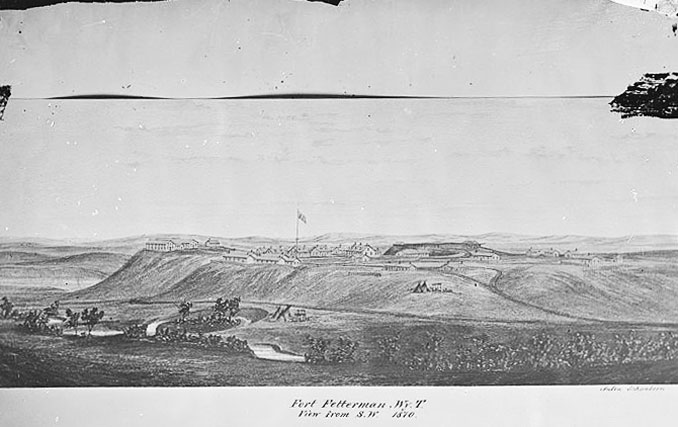
Soon, an upstart settlement just eight miles away began to eclipse the former fort. The new community, which was to become the city of Douglas, began life as three tents--a general store, a restaurant and a saloon--mostly everything a frontier town required.
These establishments drew customers from the surrounding area, along with the sort of trouble that often came with such places—bar brawls and the occasional gunfight. But this was a fleeting period in the city's history. Ultimately, Douglas followed the pattern seen in frontier towns from Dodge City to Deadwood. First came a rip-roaring period fueled by booze and bullets. Then came the railroad and that changed everything.
The Fremont, Elkhorn and Missouri Valley Railroad, building west from Chadron, Nebraska, reached Douglas in 1886. The first passenger train rolled in on Aug. 29 and disgorged a new class of residents, permanent settlers who transformed the tent settlement into a town. They soon put together the ingredients for civilization: religion, government, finances and law.
For two months after these settlers arrived, Douglas was abuzz with the sounds of construction. Streets were laid out. Permanent structures went up. Trees were planted.
It took time, however, for the civilizing influence of the newcomers to overcome the existing culture. Twenty-five bars sprang up in Douglas, drawing a ready clientele from railroad workers and cowboys.
Even so, organized religion gained a foothold. Though Douglas lacked a church, the theological students who reportedly conducted the first services made do with what was plentiful—barrooms. On days the services were held, a makeshift barrier blocked off the bar from the congregation while a card table sufficed for an altar.
For a brief time, the old West and the new West lived in uneasy coexistence. In 1886, the year Douglas incorporated, the town's first official cemetery opened in "Poverty Flats," a bit of prairie north of the tent town. The first person to be buried there was one A.H. Meyers, the loser in a gunfight. The Pioneer Cemetery, as it’s now called, remains on the site today.
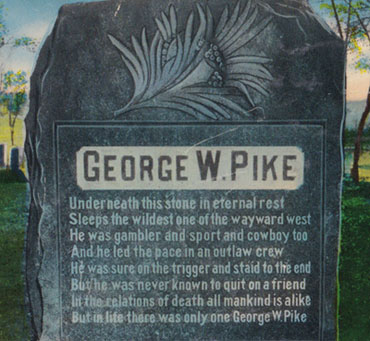
But the new West—the West dominated by settlers who sought more peaceful ways—won in the end. Anyone who watches western movies knows the script. The gunfights stopped; the old West faded.
A Winning Formula: Vote Early, Vote Often
Two years after the railroad arrived in Douglas, Converse County was created from pieces of two existing counties, Albany and Laramie, and named for Amasa Converse, a noted pioneer and Cheyenne banker.
One of the biggest decisions the citizens of the young county faced was the selection of a county seat. The chosen town would reap the economic benefits of government jobs as well as an edge for future development. Four sites wanted this designation: the former Fort Fetterman; Douglas; Glenrock where the new railroad crossed Deer Creek near the old stage-station site; and Lusk, 55 miles east of Douglas and now in Niobrara County. A popular vote was scheduled to determine the winner.
With so much at stake, some residents appear to have followed the oft-quoted recipe for winning elections in Chicago, “Vote early, vote often.” People named O'Brien were particularly active on Converse County election day. While there were only 16 people by that name residing in the county, 69 O'Briens voted.
"A Captain O'Brien was one of the election judges,” historians writing for the Federal Writers Project in the 1930s noted. “When the names of 69 O'Briens had been counted for votes, the captain shouted, 'No more O'Briens today.’" How they voted isn't known, but Douglas won the election.
The Boom-Bust Cycle
People in the area quickly discovered that in the West, epic busts often follow the good times. These economic swings are rooted in the nature of the region's economy. Wyoming doesn't produce consumer products that people buy in both good times and bad, such as toothpaste or soap. Instead, the state produces commodities—like beef, oil, gas, coal and uranium, for example—that are subject to wide swings in demand and price.
Cattle ranching is particularly vulnerable to busts because much of livestock production is at the mercy of the weather. The ranching bust of the late 1880s, when many cattlemen set themselves up for calamity by trying to graze more cattle than the range could support, illustrates the point.
In the early and mid 1880s, optimistic ranchers brought cattle from as far away as Texas to forage the area's grasslands. By 1885, the beef market was weakening and there were clear signs of overgrazing on the range. By the summer and fall of 1886, many cattle were weak and thin from lack of food.
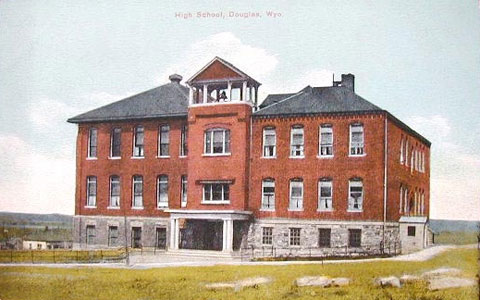
Then came a terrible winter, with severe storms followed by thaws that spread a sheet of ice over the ranges, followed by more storms. Animals perished by the thousands. These losses collapsed the area's cattle-dependent economy and many people left. Douglas in particular suffered; three-quarters of its population headed elsewhere.
Amid these economic ups and downs, officials of the new county also wrestled with civic issues. As the turn of the century approached, the citizenry had to decide whether to replace their old cemetery. Though it was less than 15 years old, backers of a new burial ground pressed their case. One of the most vocal was Bill Barlow, the witty and sometimes acid-tongued editor of the Douglas Budget newspaper.
"If there is one thing above another that Douglas needs, it is a cemetery somewhere within reach and one that could be made in a fairly half-way presentable condition," Barlow editorialized in 1899. "It fairly gives a man the horrors to think of being buried in the dismal out-of-the way sand hill now being used for that purpose."
Two years passed without a decision. Then Barlow fired another salvo. "Every death accentuates the fact that we need a cemetery," he wrote. "The one in use now is too far from town and where neither trees nor grass can be made to grow - a bleak sandy waste." Just two months later, the project was underway. Now called Douglas Park Cemetery, it has been in use since 1902.
A Night to Remember
The first passenger train brought settlers and civilizing influences to Converse County, helping to end the violence of the lawless West. But on Sept. 27, 1923, the great Glenrock train wreck proved far more deadly than any gunfight.
In the days before the accident, heavy rains had turned the usually dry streambed of Cole Creek, east of Glenrock near the Natrona County line, into a torrent the width of a small river. By the time the Chicago, Burlington and Quincy passenger train approached the creek, the railroad bridge had washed out.
The engine plunged into the waters, pulling car after car after it. The baggage coach crashed atop the engine, crushing it "like an eggshell," according to the Associated Press. The smoker car followed and was submerged completely; more lives were lost there than in any other car. All told, 30 of the train's 66 passengers and crew were killed. It was the worst train accident in the state's history.
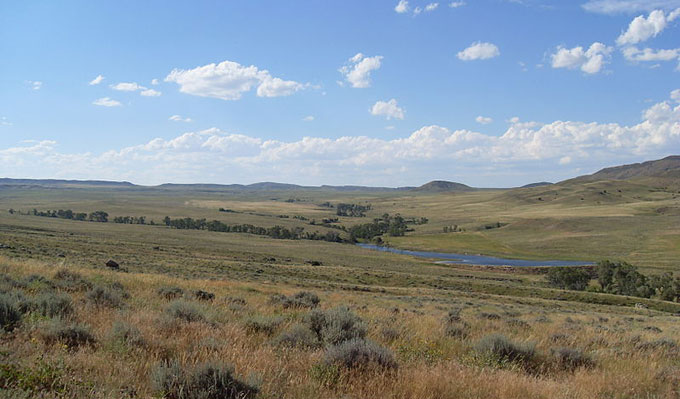
The Modern County
Today, Converse County survives on the same economic formula that sustains much of the West: a mix of agriculture, energy and tourism. The county's success runs contrary to the view of 19th century skeptics who saw Wyoming and its sister western states as a region without a future. Daniel Webster, who served as congressman, senator and U.S. Secretary of State from the early to mid-19th century, deemed the West "a region of wild beasts, shifting sands, whirlwinds of dust, cactus, and prairie dogs. It was not worth a cent."
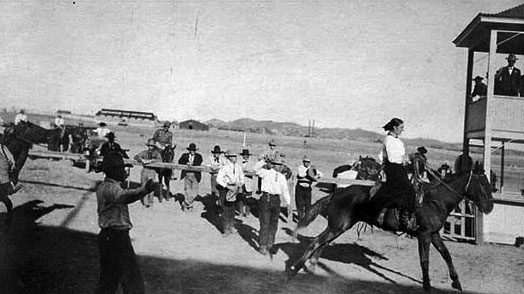
But the people who settled Wyoming found ways to survive. Tourists continue to come by the millions to the state every year—and by the tens of thousands to Converse County—to see the very things that Webster ridiculed. Cattle still graze the plains and fortunes in oil and minerals have been uncovered beneath the surface of the land. The North Platte River, which runs through Converse County, helps sustain people, crops and livestock. The state's often-cursed wind helps produce electric power.
In Converse County, Glenrock is home to the 762-megawatt Dave Johnson coal-fired power plant. The county also boasts coal mining and oil, gas and uranium production. The energy resources include the Big Muddy Oil Field near Glenrock, which boomed after it was developed during World War I. Today, more than nine decades later, it continues to produce, albeit on a small scale.
Mile-long trains carry coal from the Power River Basin through Converse County to markets in the Midwest and East. Wind farms may become one of the county's big energy sources of the future. As of 2013, two 50-megawatt wind projects are planned for sites south of Glenrock. These have the potential to produce enough power for 35,000 homes.
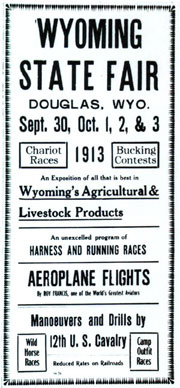
Converse County is blessed with a first-rate location on Interstate 25, the highway corridor that runs from El Paso through Colorado Springs, Denver, Fort Collins, Cheyenne and Casper. In addition, major freight rail traffic passes through the county on the Burlington Northern/Santa Fe system.
Even so, the county's location has not enabled it to land developments that have powered growth in neighboring Natrona County—home to a regional mall, major hospitals, a community college and an international airport. Instead, Converse County has made do with smaller developments that arrived piecemeal over the course of the 20th century. Collectively, they added enough jobs to allow Converse County to avoid the fate of other rural counties where population is dwindling. The county's population jumped nearly 15 percent to 13,833 between 2000 and 2010, according to U.S. Census data.
Two Magnets for Tourists: A State Fair and a Fossil Museum
In 1905, Converse County for the first time hosted the Wyoming State Fair, which celebrates the state's agricultural roots. The Wyoming Legislature awarded the fair to Douglas and appropriated $10,000, an enormous sum, for land, buildings and other expenses.
The money was soon gobbled up with preliminary work, however, leaving the citizens of Douglas to foot the bill for the rest. They came up with more funds, and the fair opened the same year.
The fair has been held in Douglas nearly every summer since. It was cancelled in 1935-36 because of the Depression, in 1937 for an outbreak of infantile paralysis, and during the war years 1942-45 when gasoline and tires were rationed. The fair now boasts a Professional Rodeo Cowboys Association rodeo as well as numerous events sponsored by 4-H groups and Future Farmers of America. Attendance runs in the tens of thousands annually, a massive increase from the 2,500 visitors the first year.
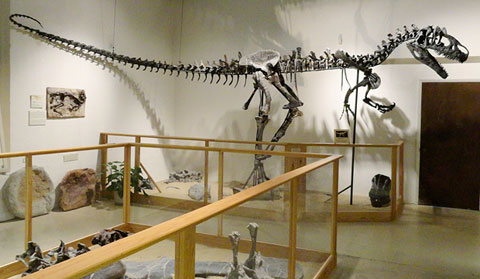
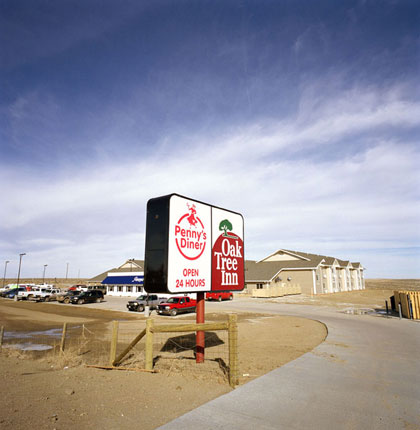
|
The 1995 discovery of Triceratops fossils on a ranch near Glenrock led to the creation of another tourist draw, the Paleon Museum in downtown Glenrock. While this may seem an odd place for a dinosaur museum, the rancher whose property held the fossils allowed further excavation only if the that the Triceratops stayed in Glenrock. Displays feature fossils from the Cretaceous, Jurassic and Oligocene eras.
As new fossils are found, a team of volunteers cleans and prepares them for display at the museum's eight prep tables, each equipped with magnifying lights, picks, brushes, glues, microscopes and other equipment.
A “Boomlet” in Bill
The history of the west is only partly one of unchecked development. It is also the story of failure and abandonment. The region is home to innumerable ghost towns that once were thriving communities. Yet some prime candidates for abandonment were able to hang on and, by perseverance, luck or some of both, even managed to grow. One of those is unincorporated Bill, Wyo., 35 miles north of Douglas on Wyoming Highway 59, notable for its name and for the fact that, for a long time, very few people lived there.
Under normal circumstances, no one would move to Bill, which acquired its name from three or four early settlers with the same first name. But Bill has one advantage, its location on a Union Pacific Railroad line built in the 1970s to ship out coal from strip mines in the Powder River basin.
The railroad needed a hotel and restaurant complex to serve its crews during mandatory rest periods. In 2007, the complex opened. In a town that used to be a gas pump and a single store where a person could buy a handgun and a sixpack of beer, Bill now boasts a busy 112-room motel and a 24-hour diner.
The West is a place where some early settlements survive and thrive while others do not. Douglas is an example of the former, Bill a case in point of the latter. Still, Bill survived the ultimate consignment to oblivion - the ghost town. And thanks to the Union Pacific development, Bill has a future.
While this may not have been much of a development by big-city standards, it was a reason for Bill to survive in the 21st century, and made an ideal offbeat feature story on the rural West. In 2008, The New York Times reported, "For decades, this speck of a place called Bill had one, two or five residents, depending on whether you counted pets. But recent developments have increased the population to at least 11, so that now Bill is more a dot than a speck, and could be justified if one day it started to call itself William."

Resources
- Barry, Dan. “In a Town Called Bill, A Boomlet of Sorts.” The New York Times, March 3, 2008. Accessed Feb. 27, 2013, at http://www.nytimes.com/2008/03/03/us/03land.html?_r=1&.
- City of Douglas. “Converse County Multi-Hazard Mitigation Plan.” Accessed Feb. 27, 2013, at http://www.cityofdouglaswy.com/vertical/Sites/%7B52347BB1-2476-45A1-A80E-FDF4BD158A35%7D/uploads/3._CC_Multi-hazard_Mitigation_Chpt_1_thru_3.pdf.
- _________________. “History of Pioneer Cemetery, Douglas, Wyoming.” Accessed Feb. 27, 2013, at http://www.cityofdouglaswy.com/vertical/Sites/%7B52347BB1-2476-45A1-A80E-FDF4BD158A35%7D/uploads/%7B11C5944F-EA97-4AD7-B45B-DA5134B99568%7D.PDF.
- “Dave Johnston Plant,” Pacificorp. Accessed March 14, 2013 at http://www.pacificorp.com/content/dam/pacificorp/doc/Energy_Sources/Ener... .
- Donahue, Jim, ed., Wyoming Blue Book. Cheyenne: Wyoming State Archives, Department of Commerce, 1991, vol. V, part 1, 177-180.
- Federal Writers Project. Wyoming - A Guide to Its History, Highways, and People. Lincoln, Neb.: University of Nebraska Press, 1981, 107, 283, 285-286, 357.
- GenDisasters. “Glen Rock, WY Train Wreck Sept. 1923.” Accessed Feb. 27, 2013, at http://www3.gendisasters.com/wyoming/4346/glen-rock,-wy-train-wreck,-sept-1923.
- North East Wyoming Economic Development Coaltion. “Counties: Converse County.” Accessed Feb. 27, 2013, at http://www.newedc.com/about.html.
- Paleon Museum. Accessed Feb. 27, 2013, at http://paleon.org/.
- Pitcher, Don. Wyoming Handbook. Chico, Calif.: Moon Publications Inc., 1991, 154.
- U.S. Census Bureau. “State and County Quick Facts.” Accessed Feb. 27, 2013, at http://quickfacts.census.gov/qfd/states/56/56009.html.
- Waller, Lee Roy. "Economic History and Settlement of Converse County, Wyoming." Annals of Wyoming, vol. 7, no. 1 (July 1930) pp. 330-336, accessed March 14, 2013 at http://archive.org/stream/annalsofwyom714193031wyom#page/n1/mode/2up
- Wyoming State Fair. “History.” Accessed Feb. 27, 2013, at http://www.wystatefair.com/about/history.php.
- Wyoming State Parks, Historic Sites & Trails.
- “Fort Fetterman Historic Site.” Accessed Feb. 27, 2013, at http://wyoparks.state.wy.us/Site/SiteInfo.aspx?siteID=19.
Illustrations
- W.H. Jackson’s 1870 sketch of Fort Fetterman is from the National Archives, via Wikipedia. Used with thanks.
- The postcard of George Pike’s gravestone is from the collection of Tom Rea.
- The images of the state fair poster, Goldie St. Clair and Douglas High school are all from Wyoming Tales and Trails. Used with thanks. See dozens more historic photos of the state fair, Douglas and Converse County at the same location.
- The photos of hotel and café at Bill, Wyo. the Union Pacific trains near Bill are by Angel Franco of the New York Times, from Dan Barry’s 2008 article. Used with thanks.
